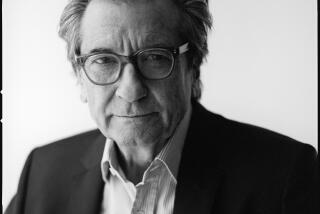The melancholy musician
The conditions under which artists flourish can tell us a lot about their personalities and what may lie behind their art but often tell us little about the art itself. For anyone writing a biography, this can be a nasty little problem. Mozart, for example, liked to be in the thick of things. He thrived on social interaction, loved parties, billiards and games, traveled, performed a lot and longed for the hubbub of the opera house. Beethoven, on the other hand -- while he surely craved human contact and fantasized about the kind of domestic bliss Mozart apparently enjoyed -- sought solitude and preferred long walks in the country with a sketchbook as his only companion to rounds of soul-numbing soirees in the salons of Viennaâs nobility or lonely dinners in the saloons of its bourgeoisie.
Yet Beethovenâs music was often exuberant and joyously extroverted, especially when it sought, as in the Ninth Symphony, to embrace millions, while Mozartâs could be dark, introspective and, in certain of his minor-key works, amazingly grim and anguished. Recognizing that itâs impossible to talk about the life of an artist without at some point delving into his works, and that it serves at best a narrow academic purpose to examine the works without searching for some context in the life, itâs still a rare book that succeeds in giving the reader both a glimpse of the world in which the artist lived and a meaningful overview of his work. Most writers concentrate on one thing or the other, depending on where their skills lie.
Benita Eislerâs skills are definitely those of a historian and biographer rather than a musicologist, and âChopinâs Funeral,â notwithstanding its rather novelistic title, is clearly intended to be a âlifeâ portrait of its subject rather than a thorough exploration of his life and works. In its sensitive re-creation of the time and place in which Chopin lived, and its painstaking and detailed observation of events -- as though Eisler were writing about things she had seen -- this elegantly slim volume takes its place at the head of, yet apart from, a long list of biographical tributes to the Romantic eraâs most elusive and hermetic composer. Whatâs more, even though the art is subordinate to the artist here, Eisler, without losing the thread of her narrative, lends a perceptive ear to Chopinâs music, which gives her book, if not completeness, at least a satisfying kind of integrity.
Chopin presents the would-be biographer with a special challenge, which may have been what led Eisler to take him on. For Chopinâs life was a symbiosis: a mutually dependent union, during the years that mattered most, with the writer George Sand. So, like every biography of Chopin that has come before it, this one is really the story of Chopin and Sand. Eisler has had some experience in this vein, having written a joint biography of Georgia OâKeeffe and Alfred Stieglitz. But what really seems to have helped prepare her for the assignment is her authorship of a biography of Byron -- who, like Chopin, lived his life shadowed by illness, troubled by fame, confused about women and, in the end, celebrated mainly by foreigners ... and whose genius, like Chopinâs, burned brightly and quickly.
But where Byron was a man of action, Chopin, the hothouse flower of Romanticism, was perhaps the most passive great artist in history. In this essential trait he differed not only from Byron but also from his friends Eugene Delacroix and Franz Liszt, those titans of the canvas and keyboard who were perpetually stirring things up. While Chopin loved the social whirl of Paris and thrived on contact with other artists, he needed very special circumstances in which to compose. Even though he was a master of improvisation, it took a long time for ideas and pieces to gestate in his mind. And for that to happen, he needed to be in a figurative womb: nurtured by a peculiar kind of companionship and assured of comfort, not of the purely physical kind -- although that was important -- but emotional, at the level of a child who knows his mother loves him. Sand provided it.
In many ways, Sand wore the pants in the family, and the contrast between her temperament and Chopinâs is probably what made the relationship work. She was a radical social activist, he a complacent, conservative and devout Catholic. She was a prodigious worker who cranked out potboilers the way a butcher makes sausages. He created a slimmer oeuvre than any of his important contemporaries (to say nothing of Sandâs enormous output, almost all of it second or third rate), but every piece he produced was a pearl. She was a world-class organizer and master manipulator, while he was given to fantasies of impotence in which he projected his weakness onto others.
Yet Sand, who had two children and managed to neglect both of them, took devoted care of Chopin. The most productive years of the composerâs career were those from 1838 to 1843, the first six years he was with Sand. The romance was effectively over by the summer of 1843, but Chopin continued to compose brilliantly for another year or so, with a new refinement and complexity (along with a newly rich sense of ambivalence) emerging in the works of 1844-45, for example, the Opus 55 nocturnes, the Opus 56 mazurkas and the Sonata in B minor, Opus 58. He composed hardly anything of importance after the final break with Sand in 1847; his tuberculosis, which Sand had held at bay all the years she was his mistress, took him in 1849.
And so Chopinâs funeral, with which Eisler begins her account of Chopinâs life, comes to be seen by the end of her book as the funeral of a man who had already gone to his grave -- the improbably public climax of an intensely private life that withered once the bond with Sand dissolved. It also serves as a metaphor for Chopinâs life, which even in its fullest moments, with Sand, was heavy with mortality. Here, at least, is one point at which the life tells us something about the art. For as Eisler notes several times in her narrative, there were morbid shadows in much of Chopinâs music too, evidence of a melancholy not merely of the heart but of the soul.
One might quibble with Eisler on some small matters. Liszt was a year younger than Chopin, not a year older as she implies early in the story. The clavichord is not âdeeper tonedâ than a harpsichord; itâs barely audible in a room larger than a closet. And George Bernard Shaw hardly championed Brahms, whom he mocked as the most âwantonâ of composers.
But one has a much easier time finding things to admire. Eislerâs characterization of the nocturne as âurban pastoralâ is one of many felicities to be savored here; her assessment of improvisation as â[l]ying somewhere between a skill and a stuntâ is another. She offers some interesting thoughts on Chopinâs late style, on what it felt like to live in the Paris of Balzac (before Haussmann drove the boulevards through) and on the aspirations of âsubject people,â that is, the Poles, for whom âthe historical shaded into the nationalist and the patriotic.â Eislerâs high-calorie diction occasionally misfires, but more often than not it lends a patina to her writing that works well with the subject. After all, a book about Chopin should consist of polished, well-turned phrases that go to the core of things.
Witnesses report that Chopinâs playing was extraordinary mainly for its finesse, that what he could achieve through touch captivated his listeners. As a portrait of one of musicâs most prescient and intriguing figures, âChopinâs Funeralâ has something of that same touch. The writing is sympathetic in the best sense, penetrating, detailed and illuminating on many levels. Even the bookâs dust jacket, with its simulation of decorative end-papers and cracked leather binding, evokes the era with fidelity.
More to Read
Sign up for our Book Club newsletter
Get the latest news, events and more from the Los Angeles Times Book Club, and help us get L.A. reading and talking.
You may occasionally receive promotional content from the Los Angeles Times.








